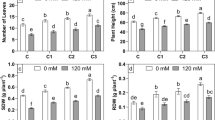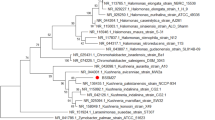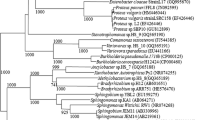Abstract
There is an increasing interest for plant growth-promoting rhizobacteria (PGPR), particularly those associated with plants originating from extreme environments like saline habitats. We are assessing, here, whether the inoculation with three PGPR bacteria strains isolated from the rhizosphere of Hordeum maritimum naturally growing in saline soil could mitigate the impact of high salinity (200 mM of NaCl) on two contrasting local barley cultivars. The affinity of interaction between plant and bacteria in response to this environmental constraint was also evaluated. At 200 mM of NaCl, the strains S1 of Bacillus mojavensis and S2 of B. pumilus maintained the highest level of indole acetic acid production and the strain S3 of Pseudomonas fluorescens the highest number of viable cells. In the salt-sensitive cultivar Rihane, salinity reduced significantly plant biomass, chlorophyll and shoots water contents and enhanced malondialdehyde leaf content. Salt impact was also related to higher Na+ uptake. However, these parameters were slightly altered under salinity in the tolerant cultivar Kerkna which is likely due to its ability to transport Na+ to shoots for osmotic adjustment. The effect of bacteria inoculation on barley growth and tolerance to salt stress was dependent on the bacteria and cultivar genotypes and their interactions with the salinity of the soil. At 0 mM of NaCl the strain S2 increased significantly the plant fresh biomass of both cultivars. At 200 mM of NaCl, a positive effect on Rihane plant biomass was observed after S1 strain inoculation, while the Kerkna plant biomass did not change significantly after bacteria inoculation. Overall, the sensitive cultivar Rihane responds better to bacteria inoculation in comparison to the tolerant cultivar under control and salt conditions, which demonstrate a certain affinity of interaction between plant cultivar and bacterium strain modulated by the salinity of the soil. The multitude of soil–plant–microbe interactions, and in particular this affinity-effect observed between plants and rhizobacteria modulated by soil conditions, constitute a challenge for developing bio-promoting inoculum at the commercial level. This constraint can possibly be managed by developing an inoculum containing a consortium of PGPR bacterial strains having broad spectrum interactions with different plant cultivars that function optimally under several environmental constraints.
Similar content being viewed by others
References
Abbaspoor A, Zabihi HR, Movafegh S, Akbari Asl MH (2009) The efficiency of plant growth promoting rhizobacteria (PGPR) on yield and yield components of two varieties of wheat in salinity condition. Am-Eurasian J Sustain Agric 3:824–828
Afrasayab S, Faisal M, Hasnain S (2010) Comparative study of wild and transformed salt tolerant bacterial strains on Triticum aestivum growth under salt stress. Braz J Microbiol 41:946–955
Albacete A, Ghanem ME, Martínez-Andújar C, Acosta M, Sánchez-Bravo J, Martínez V, Lutts S, Dodd IC, Pérez AF (2008) Hormonal changes in relation to biomass partitioning and shoot growth impairment in salinized tomato (Solanum lycopersicum L.) plants. J Exp Bot 59:4119–4131
Allel D, Ben-Amar A, Badri M, Abdelly C (2016) Salt tolerance in barley originating from harsh environment of North Africa. Aust J Crop Sci 10:438–451
Andreote FD, Lacava PT, Gai CS, Arau´jo WL, Maccheroni WJ, van Overbeek LS, van Elsas JD, Azevedo JL (2006) Model plants for studying the interaction between Methylobacterium mesophilicum and Xylella fastidiosa. Can J Microbiol 52:419–426
Bacon CW, Hinton DM (2002) Endophytic and biological control potential of Bacillus mojavensis and related species. Biol Control 23:274–284
Bal HB, Nayak L, Das S, Adhya TK (2013) Isolation of ACC deaminase producing PGPR from rice rhizosphere and evaluating their plant growth promoting activity under salt stress. Plant Soil 366:93–105
Baraket M, Sahli A, Amara H, Nasr H, Selmi H, Trifa Y (2014) Introduction and evaluation of salt-tolerant barley genotypes. Ann Biol Res 5:64–69
Berg G (2009) Plant–microbe interactions promoting plant growth and health: perspectives for controlled use of microorganisms in agriculture. Appl Microbiol Biotechnol 84:11–18
Blumwald E (2000) Sodium transport and salt tolerance in plants. Opin Cell Biol 12:431–434
Cakmakci R, Donmez MF, Erdogan U (2007) The effect of plant growth promoting rhizobacteria on barley seedling growth, nutrient uptake, some soil properties and bacterial counts. Turk J Agric 31:189–199
Cheeseman JM (1988) Mechanisms of salinity tolerance in plants. Plant Physiol 87:547–550
de Bashan LE, Hernandez JP, Bashana Y, Maiera RM (2010) Bacillus pumilus ES4: candidate plant growth-promoting bacterium to enhance establishment of plants in mine tailings. Environ Exp Bot 69:343–352
Debez A, Ben Hamed K, Grignon C, Abdelly C (2004) Salinity effects on germination, growth and seed production of the halophyte Cakile maritima. Plant Soil 262:179–189
Dodd IC, Pérez-Alfocea F (2012) Microbial amelioration of crop salinity stress. J Exp Bot 63:3415–3428
Draper HH, Hadley M (1990) Malondialdehyde determination as index of lipid peroxidation. Methods Enzymol 186:421–431
El Felah M, Medimagh S (2005) Food barley in Tunisia. In: Grando S, Macpherson HG (eds) Food barley: importance, uses and local knowledge. Aleppo, Syria, pp 29–35
Fabio FDM, Eliane AG, Seldin L (2008) Auxin production and detection of the gene coding for the auxin efflux carrier (AEC) protein in Paenibacillus polymyxa. J Microbiol 46:257–264
Golpayegani A, Tilebeni HG (2011) Effect of biological fertilizers on biochemical and physiological parameters of basil (Ociumum basilicm L.) medicine plant. Am-Eurasian J Agric Environ Sci 11:411–416
Gordon SA, Paleg LG (1957) Observations on the quantitative determination of indoleacetic acid. Physiol Plant 10:39–47
Goswami D, Dhandhukia P, Patel P, Thakker JN (2014) Screening of PGPR from saline desert of Kutch: growth promotion in Arachis hypogea by Bacillus licheniformis A2. Microbiol Res 169:66–75
Hafsi C, Lakhdhar A, Rabhi M, Debez A, Abdelly C, Ouerghi Z (2007) Interactive effects of salinity and potassium availability on growth, water status, and ionic composition of Hordeum maritimum. J Plant Nut Soil Sci 170:469–473
Hallmann J, Quadt-Hallmann A, Mahaffee WF, Kloepper JW (1997) Bacterial endophytes in agricultural crops. Can J Microbiol 43:895–914
Hernández JA, Almansa MS (2002) Short term effects of salt stress on antioxidant systems and leaf water relations of pea leaves. Physiol Plant 115:251–257
Hewitt EJ (1966) Sand and water culture methods used in the study of plant nutrition. Commonwealth Bureau of Horticulture and Plantation Crops Tech Commun 22
Kinraide TB (1999) Interactions among Ca2+, Na+, K+ in salinity toxicity: quantitative resolution of multiple toxic and ameliorative effects. J Exp Bot 50:1495–1505
Lichtenthaler HK (1987) Chlorophylls and carotenoids, the pigments of photosynthetic biomembranes. In: Douce R, Packer L (eds) Methods in Enzymology, vol 148. Academic Press Inc, New York, pp 350–382
Liu ZL, Sinclair JB (1993) Colonization of soybean roots by Bacillus megaterium B153-2-2. Soil Biol Bioch 25:849–855
Parida SK, Das AB (2005) Salt tolerance and salinity effects on plants. Ecotoxicol Environ Safety 60:324–349
Rosenblueth M, Martinez-Romero E (2006) Bacterial endophytes and their interactions with hosts. Mol Plant Microb Interact 19:827–837
Salomon MV, Bottini R, de Souza Filho GA, Cohen AC, Moreno D, Gil M, Piccoli P (2014) Bacteria isolated from roots and rhizosphere of Vitis vinifera retard water losses, induce abscisic acid accumulation and synthesis of defense-related terpenes in vitro cultured grapevine. Physiol Plant 151:359–374
Schmidt B, Samfira I (2015) Effect of salt tolerant edaphic microorganisms on tomato local landraces during germination in osmotic stress conditions. Bull UASVM Hortic 72(2):11361
Shabala S, Cuin TA (2008) Potassium transport and plant salt tolerance. Physiol Plant 133:651–669
Shrivastava P, Kumar R (2015) Soil salinity: a serious environmental issue and plant growth promoting bacteria as one of the tools for its alleviation. Saudi J Biol Sci 22:123–131
Vardharajula S, Zulfikar AS, Grover M, Reddy G, Bandi V (2011) Drought-tolerant plant growth promoting Bacillus spp: effect on growth, osmolytes, and antioxidant status of maize under drought stress. J Plant Interact 6:1–14
Viebahn M, Doornbos R, Wernars K, Van Loon LC, Smit E, Bakker P (2005) Ascomycete communities in the rhizosphere of field-grown wheat are not affected by introductions of genetically modified Pseudomonas putida WCS358r. Environ Microbiol 7:1775–1785
Weisburg WG, Barns SM, Pelletier DA, Lane DJ (1991) 16S ribosomal DNA amplification for phylogenetic study. J Bacteriol 173:697–703
Zhang H, Kim MS, Sun Y, Dowd SE, Shi H, Paré PW (2008) Soil bacteria confer plant salt tolerance by tissue-specific regulation of the sodium transporter HKT1. Mol Plant Microb Interact 21:737–744
Acknowledgements
We are grateful to Dr. Dorsaf Allel and Dr. Ahmed Debez for generous help and critical reading of the manuscript. This study was supported by funds from the Tunisian Ministry of Higher Education and Scientific Research.
Author information
Authors and Affiliations
Corresponding author
Additional information
Communicated by M. H. Walter.
Rights and permissions
About this article
Cite this article
Mahmoud, O.MB., Slimene, I.B., Zribi, O.T. et al. Response to salt stress is modulated by growth-promoting rhizobacteria inoculation in two contrasting barley cultivars. Acta Physiol Plant 39, 120 (2017). https://doi.org/10.1007/s11738-017-2421-x
Received:
Revised:
Accepted:
Published:
DOI: https://doi.org/10.1007/s11738-017-2421-x




